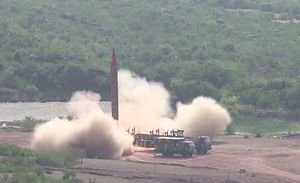On Monday, Pakistan conducted a test launch of its liquid-fueled, single-stage medium-range ballistic missile, the Ghauri or Hatf-V.
Video footage released by the Pakistani military’s Inter-Services Public Relations shows a Ghauri missile successfully launching off a transporter-erector-launcher in an undisclosed location.
The footage then cuts to show the missile’s dummy re-entry vehicle striking a land-based target. The range to which the missile was tested is left unclear and the target area does not appear to contain any structures.
“Pakistan today successfully conducted Training Launch of Ghauri Missile System,” the Pakistani Army noted in a press release. “The launch was conducted by Army Strategic Forces Command and was aimed at testing the operational and technical readiness of Army Strategic Forces Command.”
The missile “can carry both conventional and nuclear warheads up to a distance of 1300 kms,” according to the Pakistani press release. The launch was observed by a number of senior Pakistani officials, including the commander of Army Strategic Forces Command Lieutenant General Mian Muhammad Hilal Hussain.
“The launch consolidates Pakistan’s nuclear capability which is aimed at peace and stability through a credible deterrence regime,” the Pakistani statement added.
The Ghauri was last known to be test launched on April 15, 2015. That test was set up for the purpose of “testing the operational and technical readiness of Army Strategic Forces Command.”
The Ghauri is a Pakistani modification of North Korea’s Nodong ballistic missile. Pakistan is thought to possess around two dozen Ghauri missiles.
Despite remaining deployed, the Ghauri is limited in its effectiveness as a ballistic missile system in wartime. Liquid-propellant missiles like the Ghauri need to be fueled in the field before they can be launched, leaving them vulnerable to pre-emptive attack. The fueling process can take upwards of two hours.
In recent years, Pakistan has largely moved its practical land-based deterrent forces to solid-fuel systems like those in the Shaheen series. The missile’s propellant is built into the airframe in long-range solid-fuel ballistic missiles, making them highly survivable and responsive. These missiles are available for use as they become necessary.
In recent years, Pakistan has started developing new systems, including a submarine-launched cruise missile known as the Babur-3 and a multiple independently targetable re-entry vehicle (MIRV) capable medium-range ballistic missile known as the Ababeel.

































